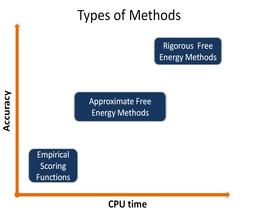The application and critical assessment of protein-ligand binding affinities
- Research Team
- Ioannis Haldoupis
- Investigators
- Jonathan Essex

Can simplified approximate methods produce qualitative agreement with experiment across a range of systems? Are they reproducible? How do they compare with the lower and higher end of the methodology spectrum? What can we learn?
Most drugs exert their action by binding to a macromolecule target, i.e., a protein. Hence, estimating the binding affinity, or in other words calculating a quantity called free energy of binding, using computer programs in of utmost importance in the drug design process. Traditionally, experimental high-throughput screening (HTS) is used to find active molecules, or hits, that can be subsequently optimized into leads with the required potency, solubility, etc. Typically, attractive lead molecules are the basis of lead optimization programmes, where many analogues are synthesized and tested to try to arrive at a drug candidate with optimal pharmacological properties. The whole process from hit to lead, and lead to drug candidate, can be costly and lengthy. Thus, computational approaches that could predict the binding affinity of new ligands before they are synthesized could be of great value in this context. Such methods range from approximate scoring functions, through end-point methods such as LIE, MM-PBSA and MM-GBSA, and finally to more rigorous methods such as free energy perturbation or thermodynamic integration (a technique allowing morphing of one molecule to another, thus enabling the accurate estimation of relative binding free energies); however, the latter computations require significant computational resources. For this reason the use of Iridis is indispensable for this project as routine testing across a range of large datasets would be impossible without the use of a powerful HPC facility.
This project focuses on testing and assessing the estimation of binding affinity, in collaboration with Professor Jon Essex from the department of Chemistry and an industrial collaborator from Merck & Co. Despite there being numerous free energy methods available, there is little evidence in literature of any direct head-to-head comparison of these approaches to critically assess their reproducibility, accuracy and performance across a range of systems and software.
Rigorous free energy methods remain expensive making them impractical for routine use in the drug discovery process. Approximate free energy methods have recently been introduced as a fast tool to qualitatively estimate binding affinities in the lead optimization stage. There are a number of studies in the literature showing encouraging results using simplified variations of MM-GBSA as a filter to less accurate but rapid scoring functions (see image). Do they actually work and what can we learn? Initially we set out to investigate the answers to these questions by attempting to reproduce a published protocol. The same dataset is then further tested using similar methodology in a range of software highly popular within the pharmaceutical industry. This is followed by calculation using less approximate methodology, while the current focus is on performing rigorous methodology on two systems; one system that performed well using simplified approximate methods and one that didn’t, and then compare and assess our findings. The scientific goal of this collaboration is to develop a greater understanding of the relative merits of free energy calculation methods, and to improve the performance of these methods in the context of drug discovery.
Categories
Life sciences simulation: Biomolecular simulations, Structural biology
Algorithms and computational methods: Finite differences, Molecular Dynamics, Molecular Mechanics, Monte Carlo, statistical analysis
Simulation software: AMBER, ProtoMS, Schrodinger Suite
Visualisation and data handling software: Povray, VMD
Software Engineering Tools: Vim
Programming languages and libraries: Fortran, Python, R
Computational platforms: Iridis, Linux, Windows
Transdisciplinary tags: Complex Systems, HPC, Scientific Computing